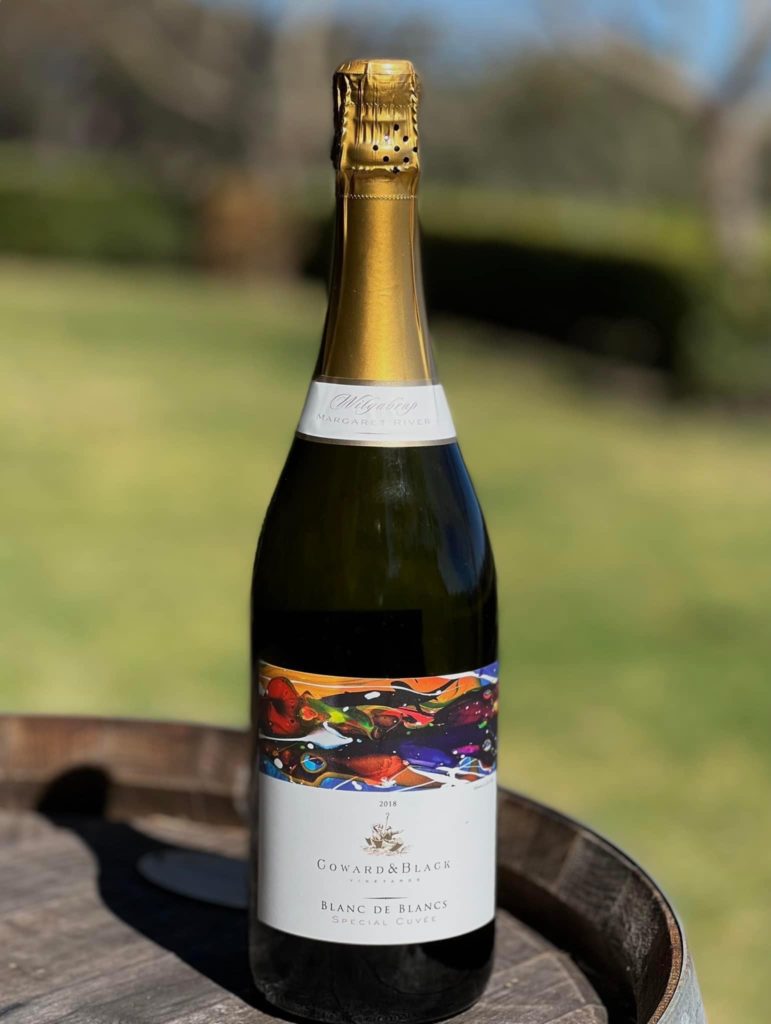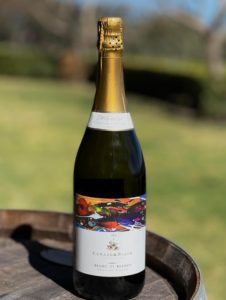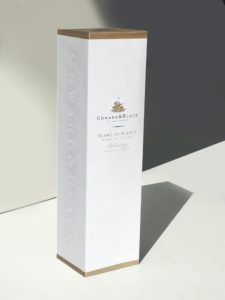
The birth of a Legend, twenty years in the making
 The first release of the Coward & Black Vineyards Special Cuvée Blanc de Blancs.
The first release of the Coward & Black Vineyards Special Cuvée Blanc de Blancs.
There was a very special moment during a family gathering in Margaret River last weekend. A moment just before dinner on Friday evening that quite literally took my breath away.
Earlier in the day we had released our first ever champagne-style sparkling wine. The launch of the 2018 Coward & Black Vineyards, Special Cuvée, Blanc de Blancs marked the culmination of a twenty year journey of faith. A high-stakes gamble driven entirely by our belief in the unique terroir of Margaret River‘s Wilyabrup sub-region and in the transformational magic of the ancient gravelly loam soils that we had discovered just beneath the surface of our farm, a former cattle property at the northernmost end of the region’s famed Tom Cullity Drive.
It is no secret that Champagne is one of my life’s great loves. A faithful companion that has been a feature of all of the happiest moments of my life. A reliable constant, accessible anywhere in the world and imbued with an uplifting magic so transcendent the father of Champagne, Dom Pierre Pérignon, famously declared that drinking it was like “tasting the stars”.
So it followed therefore, that from the moment we decided to plant our first vines in 2001, the great wine of my life loomed large over everything. At once omnipresent and unattainable. A holy grail that geography and terroir would ensure remained forever entirely ungraspable.
Almost all Champagnes are made from a blend of three grapes. Two red grapes: Pinot Noir and Pinot Meunier make up around 70% and Chardonnay makes up roughly 30% of almost all of the world’s best known Champagnes. Most people don’t realise that Champagne is made mainly from red grapes because the skins of the red grapes are separated out immediately after crushing, leaving the clear juice behind.
It was a very straightforward assessment: The chalky soils and unique micro-climate of France’s Champagne region are nothing like Wilyabrup’s rich loamy soils and moderate maritime environment. Pinot Noir is a cold climate grape that does not grow well in Margaret River and Pinot Meunier has never been grown successfully anywhere in the region. The facts were irrefutable. No matter how our winemaking journey unfolded, a premium champagne-style sparkling wine would never form a part of our range. Or would it?
In January 2004, seven years after we bought the Wilyabrup property, at a lunch for my 40th birthday, my friend Kate Lamont ordered a bottle of Ruinart Blanc de Blanc and at that moment everything changed. It was a revelation. The best Champagne I had ever tasted. And Blanc de Blancs? (White from white)? Did it mean what I thought it did? “Yes”, confirmed Kate. The Ruinart Blanc de Blancs, the most sublime, alluring and utterly delicious champagne I had ever tasted was 100% Chardonnay.
At the time Margaret River was rapidly becoming recognised as one of the best Chardonnay regions anywhere in the world. Margaret River Chardonnays were cleaning up on the world wine show circuit and only a few year’s earlier, the highly respected Wine Spectator Magazine had declared Leeuwin Estate’s Art Series Chardonnay as “The Best Chardonnay in the World”.
To me the revelation was simple and immediate. If this world class champagne I was tasting; The Ruinart Blanc de Blanc, was made from 100% Chardonnay grapes and Margaret River produced some of the best Chardonnay grapes in the world then surely it followed that Margaret River could make one of the best Blanc de Blancs in the world.
And so it was that the journey began. It turned out, of course, that the next part of the journey was slightly more complicated than the euphoric birthday lunch encounter.
The predominant Chardonnay vineyards of the Margaret River region are planted with the Gingin Chardonnay clone. The variety that was achieving all of the international acclaim, while perfect for table Chardonnay, had far too much depth and concentration of flavour for the steely clean freshness of a great Blanc de Blanc. After countless discussions and enquires and meetings with winemakers and viticulturists, we decided we would plant two different Chardonnay clones. Half would be the Gingin clone to be used to make a world class Margaret River Chardonnay and the other half would be planted with a completely different strain of Chardonnay known only as “Clone 5”. Clone 5’s big luscious grapes and bountiful bunches produced a leaner, sharper fruit, picked early before fully ripened its restrained flavour and low sugar made it perfect for Blanc de Blancs.
We planted the vineyard in 2004 but the going was tough. We had made a risky decision to establish the vineyard without irrigation. There’s an old wine making adage that the vines that struggle the most, produce the best fruit and this “dry-grown” method was fast gaining popularity. It caused the vines much stress in the early years. We lost many vines and had to hand water to keep those left alive through some of the region’s driest summers. The vines grew much slower that usual as they put all of their energy into pushing down deep into the ground looking for water. Deploying this dry-grown method meant that it would be 10 years before the vines bore sufficient fruit to make wine. And even then it was not until 2018, some 14 years after we had planted the clone 5 vineyard that we felt the fruit was ready for our first Blanc de Blanc.
Before we began, however, we had a pilgrimage to make. A sacred pilgrimage to Reims, the city at the centre of France’s Champagne region and home to the oldest Champagne house in the world – Ruinart. Dom Ruinart was Dom Perignon’s assistant Cellarer at the Haute Villiers Abbey. His nephew founded the house that bears his name in 1729, and a descendant of his greeted us at the entrance and took us to the winery for a special Masterclass. A Masterclass on the Ruinart Blanc de Blancs. An utterly beguiling afternoon during which we learned every aspect of the wine’s production from the vineyard right through to the bottle.
On our return to Margaret River we met with Winemakers Clive Otto and Ellin Tritt with a simple request. “We want you to make us a world class Blanc de Blancs. The very best you can make.” And so in in March 2018 we hand-picked the best bunches of clone 5 fruit, then gently pressed them to extract the juice. From there we followed the traditional champagne method in exacting detail, even sourcing old seasoned oak barrels deeply infused with the richness of five vintages of one of the region’s best Chardonnays, and fermenting the Chardonnay base wine directly in the barrels in exactly the same way Dom Perignon and Dom Ruinart would have done. Then under the skilled hands of John Frazer the wine was bottled and liqueur de tirage added kickstarting secondary fermentation – the magic part that gives the wine its bubbles during the the “prise de mousse” or ‘capturing the froth’ stage. So complex and detailed is this process that we had to nominate the exact PSI pressure we want the finished product to sit at, and as a consequence determined the size of the bubbles or “bead” that give the wine its luscious effervescent texture.
Then the wine sat for three years, the alluring toasty flavour of freshly baked bread slowly infusing the wine with the remnant yeast from secondary fermentation. Turning the bottles regularly to move the yeast around and infuse the wine evenly. The finished product was finally ready in October 2021, three and a half years after we picked the first grapes.
In future the annual Blanc de Blancs label will feature the winning painting from the Annual Coward and Black Art prize. But with the wine ready and the art prize not scheduled to start until next year, we commissioned local artist Rick Ward to come up with a painting for the first vintage. (If you put “Pat” and “Co” in front of “Rick” and “Ward” respectively, you’ll get to the bottom of the riddle.)
Tasting the wine on Friday was a nerve-wracking experience. So much had gone into it. When I opened a bottle and took my first sip the whole journey seemed to fly out of the glass and in an instant the overwhelming fabulousness of the wine revealed itself. I had hoped that it would be good but I was not prepared for how good it would be. It was frankly remarkable.
Never before have I felt so much connection to a wine we’ve made. No other wine has as much of us in it as this wine does. From the beginning when Martin and I planted the tiny sticks, the Chardonnay cuttings that looked like pencils and would become our dry grown vineyard, all the way through to me painting the painting on the front of the label, this wine has our hands all over it.
Just as wine so deeply captures the symbolism and meaning of other great stories, this wine in every sense captures the story of Martin and me. It is our wine, the fruit of our vines, the work of our human hands. Majestic, effervescent and full of life, it will become our spiritual drink.
Oh, and what was the moment that took my breath away? On Friday night one of the guests had opened a bottle of well-known and highly regarded French champagne. I still had a near-full glass of our new Blanc de Blancs and I put my glass down while I went to get something from my room. Five minutes later I came back and accidentally picked up the wrong glass. This glass had the French champagne in it so I asked who’s glass I had accidentally picked up. “That’s your glass” everyone declared. “You left it there. No one’s touched it.” “Nonsense” I said. “I know what French champagne tastes like.” Then my niece handed me her glass. Hers was definitely Champagne. Then I realised. My glass was indeed our Blanc de Blanc, a wine so amazing that for that one brief shining moment it was quite literally, impossible for me to believe.
Patrick Coward
November’21

